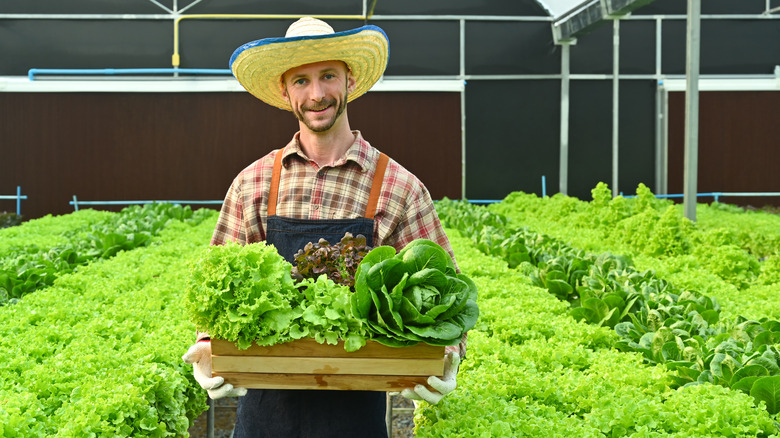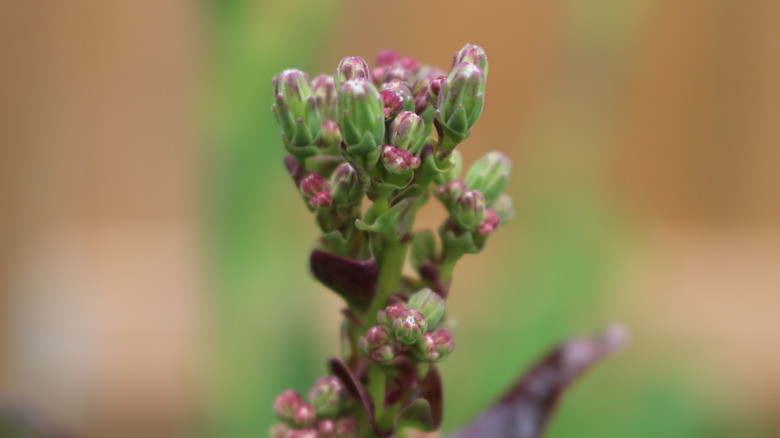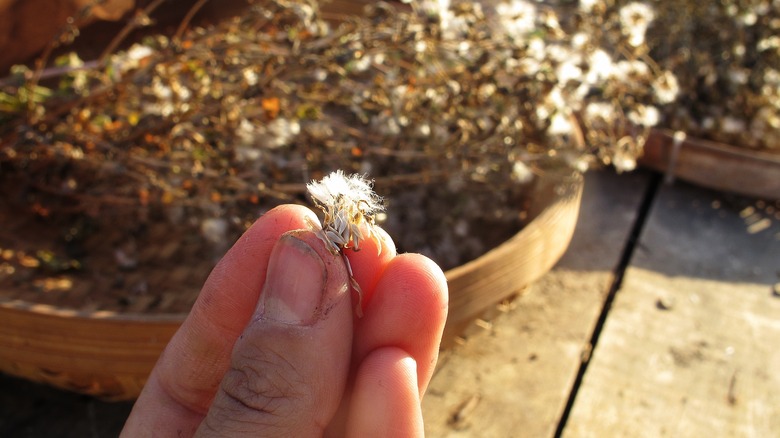TikTok's Lettuce Seed Harvesting Trick For Unlimited Crops
We may receive a commission on purchases made from links.
As summer wears on and the air turns sticky with heat, any lettuces you failed to harvest from your garden or, say, those butterhead seedlings you put in a little too late in the season to grow tall and put out a chaotic cluster of flower heads. You can't eat the leaves now; your homegrown lettuce tastes so bitter. However, all is not lost to the compost. TikToker @theretromom shares a valuable — in both a botanical and monetary sense — idea suited to the most green-thumbed of gardeners. When your lettuce shoots upwards, cut the long stems and dry the flowers. The blooms will turn into miniature dandelion clocks full of seeds you can save for planting next season.
A lettuce flowering, also called "going to seed" or "bolting" in gardener's lingo, is pretty distinctive. As described above, the plant will grow extraordinarily tall and thin from the center of the head and put out an ethereal spray of flowers. How much sunlight does a lettuce plant actually need? 6 to 12 hours. But 12 hours of that delicious Photosynthetically Active Radiation (the part of the light spectrum plants use) combined with daytime temperatures over 75 degrees Fahrenheit and little rain will set bolting in motion.
It's (seed) harvest time!
Normally, you do everything in your power to prevent your lettuce from bolting. If you want to save seeds, however, you must learn to welcome — even encourage — the process. Only seeds from heirloom or open-pollinated lettuce varieties will sprout the same plant as the parent, so plan to plant cultivars that fall under these categories. Victory Seed Company sells seeds of the undeniably pretty Waldmann's Green Leaf Lettuce for $2.95. Get 250 seeds of the ultra-cute (and tasty) Tennis Ball Lettuce for $3.00 from Rare Seeds. Go traditional with a 1,000-seed envelope of Iceberg lettuce — $2.98 from Everwilde Farms.
@theretromom Happy harvesting! Save money with this quick and easy #lettucegrowing hack from #theretromom #growyourown #lettuceseeds #gonetoseed #boltedlettuce #veggiegardenhacks #gardenhacks #lettucehacks #gardentipsandtricks
Many experts suggest waiting until lettuce seeds dry on the plant to harvest them. Then, you can simply gently pick the resulting seed heads off and stow them away for next winter. However, this isn't always practical for those who live in areas with wet summers (looking at you, Minnesotan, Dakotan, and Nebraskan gardeners), have sprinkler irrigation installed, or need to water their beds frequently. As per the aforementioned TikTok video, take a pair of sharp secateurs and snip the entire flower head cluster off at the base of the central stem while it's still green. If you're unsure if it's the right time to harvest the flower stalk, wait until at least half of the flowers have transformed into seed heads — they'll resemble tiny brown buds with white fluff coming out the top. Make sure the plants you harvest from are free of disease.
Drying and storing your seeds
If your summers are dry, simply lay the freshly harvested lettuce flower stems on the soil or lawn near the plants. They'll dry on their own — this could take as long as a week. To speed up the process, hang the stems upside down under a covered patio or in your sunroom with a catch-all, like a large bowl, underneath them to collect any seeds that fall prematurely. You can also lay them out on a drying rack — Fedco Seeds sells a nifty collapsible drying rack for $82.00.
Think strategically about how to store the resulting seeds. Everything from small plastic zip-lock or wax paper bags to upcycled spice jars will work. Amazon offers 150 self-sealing brown paper seed envelopes for just $15.99. This plastic seed storage box and container kit from Walmart costs just $14.98. A single plant can produce seeds numbering into the thousands, and each seed is notoriously itty-bitty, so it's best to be prepared.
Rub the seed heads between your fingers to release the individual seeds, and pick off the white fluff. Use tweezers if needed. Place the seeds into your prepared packets or containers, labeled with the month and year you harvested them and the name of the variety. Keep the packaged seeds in a cool, dark, dry spot in your house until the next planting season. Don't forget to share or trade any overflow with family, friends, neighbors, and other gardeners in your area.


